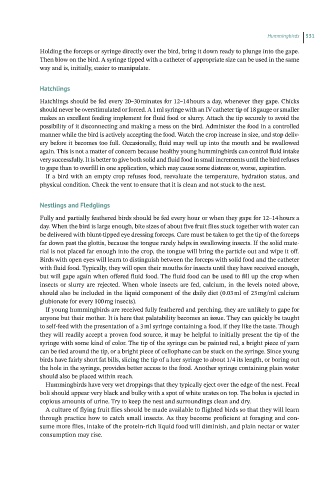Page 533 - Hand rearing birds second
P. 533
Hummingbirds 531
Holding the forceps or syringe directly over the bird, bring it down ready to plunge into the gape.
Then blow on the bird. A syringe tipped with a catheter of appropriate size can be used in the same
way and is, initially, easier to manipulate.
Hatchlings
Hatchlings should be fed every 20–30 minutes for 12–14 hours a day, whenever they gape. Chicks
should never be overstimulated or forced. A 1 ml syringe with an IV catheter tip of 18 gauge or smaller
makes an excellent feeding implement for fluid food or slurry. Attach the tip securely to avoid the
possibility of it disconnecting and making a mess on the bird. Administer the food in a controlled
manner while the bird is actively accepting the food. Watch the crop increase in size, and stop deliv-
ery before it becomes too full. Occasionally, fluid may well up into the mouth and be swallowed
again. This is not a matter of concern because healthy young hummingbirds can control fluid intake
very successfully. It is better to give both solid and fluid food in small increments until the bird refuses
to gape than to overfill in one application, which may cause some distress or, worse, aspiration.
If a bird with an empty crop refuses food, reevaluate the temperature, hydration status, and
physical condition. Check the vent to ensure that it is clean and not stuck to the nest.
Nestlingsand Fledglings
Fully and partially feathered birds should be fed every hour or when they gape for 12–14 hours a
day. When the bird is large enough, bite sizes of about five fruit flies stuck together with water can
be delivered with blunt‐tipped eye dressing forceps. Care must be taken to get the tip of the forceps
far down past the glottis, because the tongue rarely helps in swallowing insects. If the solid mate-
rial is not placed far enough into the crop, the tongue will bring the particle out and wipe it off.
Birds with open eyes will learn to distinguish between the forceps with solid food and the catheter
with fluid food. Typically, they will open their mouths for insects until they have received enough,
but will gape again when offered fluid food. The fluid food can be used to fill up the crop when
insects or slurry are rejected. When whole insects are fed, calcium, in the levels noted above,
should also be included in the liquid component of the daily diet (0.03 ml of 23 mg/ml calcium
glubionate for every 100 mg insects).
If young hummingbirds are received fully feathered and perching, they are unlikely to gape for
anyone but their mother. It is here that palatability becomes an issue. They can quickly be taught
to self‐feed with the presentation of a 3 ml syringe containing a food, if they like the taste. Though
they will readily accept a proven food source, it may be helpful to initially present the tip of the
syringe with some kind of color. The tip of the syringe can be painted red, a bright piece of yarn
can be tied around the tip, or a bright piece of cellophane can be stuck on the syringe. Since young
birds have fairly short fat bills, slicing the tip of a luer syringe to about 1/4 its length, or boring out
the hole in the syringe, provides better access to the food. Another syringe containing plain water
should also be placed within reach.
Hummingbirds have very wet droppings that they typically eject over the edge of the nest. Fecal
boli should appear very black and bulky with a spot of white urates on top. The bolus is ejected in
copious amounts of urine. Try to keep the nest and surroundings clean and dry.
A culture of flying fruit flies should be made available to flighted birds so that they will learn
through practice how to catch small insects. As they become proficient at foraging and con-
sume more flies, intake of the protein‐rich liquid food will diminish, and plain nectar or water
consumption may rise.

